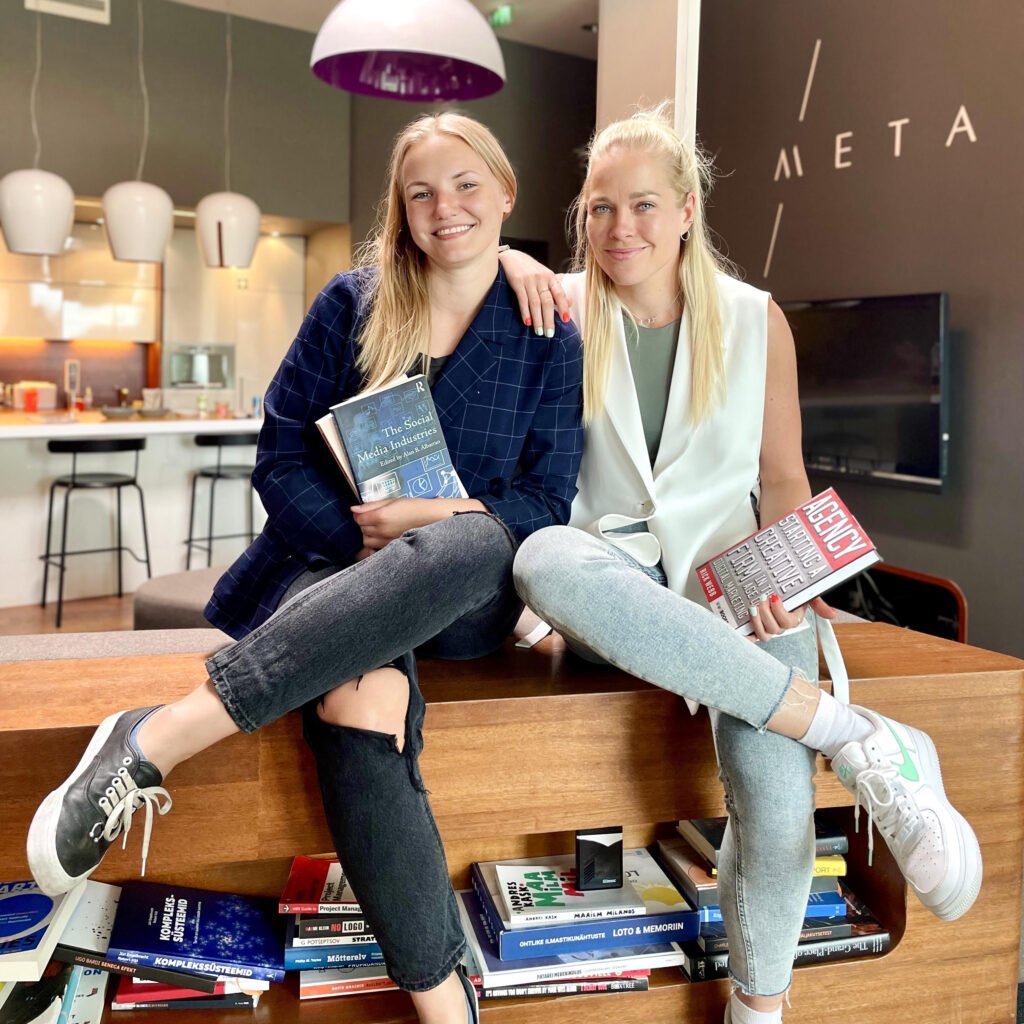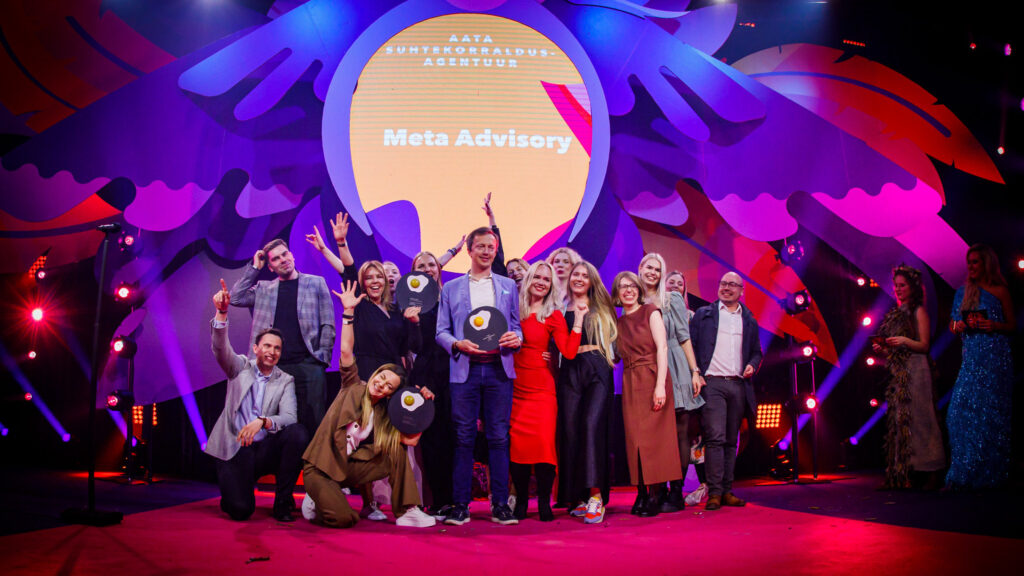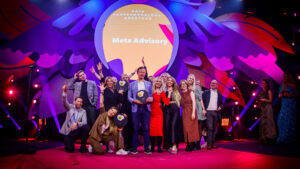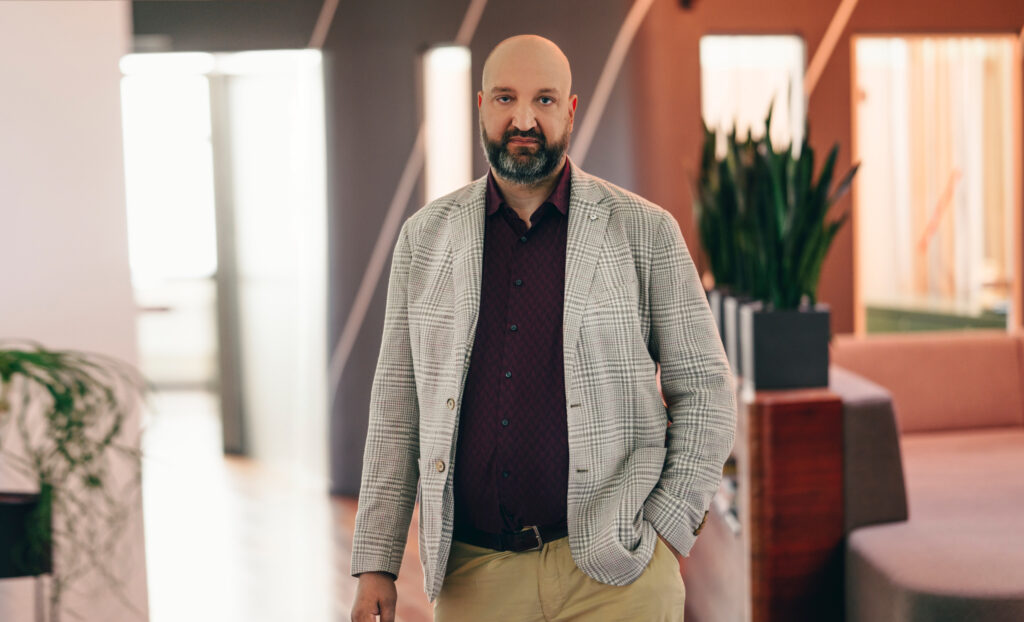Three Questions x META Digital Marketing Experts
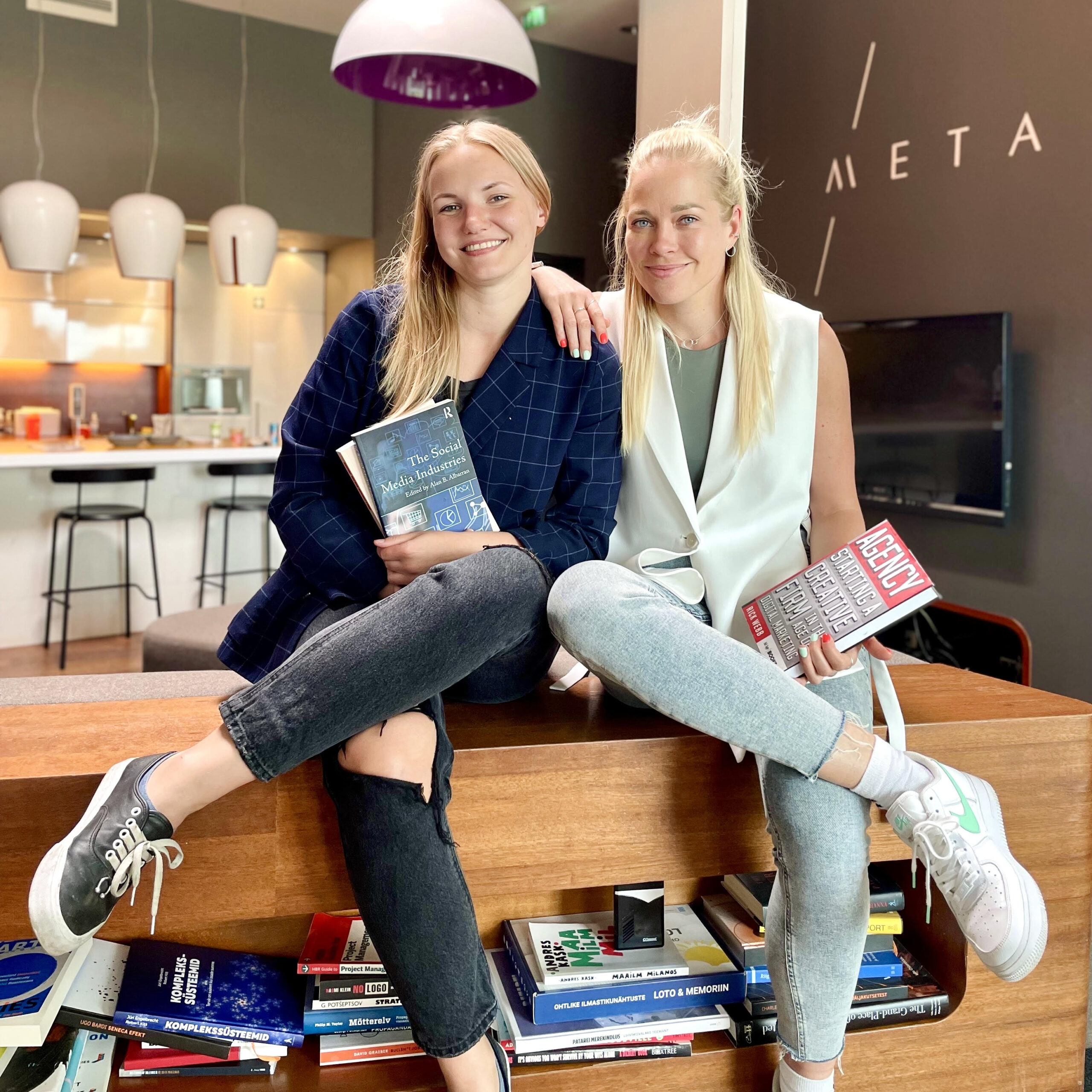

Digital communication should be seen as an organic part of well-thought-out modern PR, which must contribute to achieving corporate objectives. However, in practice, we often see a failure in noticing the opportunities that digital marketing can offer and that the basics of social media and digital marketing change so quickly that it is challenging to keep up with the latest innovations, tips, and recommendations.
That’s why we asked META’s digital marketing experts three important questions: Marketing Communications team Senior Consultant Karin Maandi and Consultant Helin Naska will help you navigate the digital and social media marketing landscape and decipher the benefits of the digital world, the most common mistakes, and the way forward.
1. What three benefits of digital marketing are often overlooked?
Karin: One of the key benefits is the ability to engage the customer better and drive their user experience. While other channels tend to be more one-way in communicating a company’s message or point of view, digital channels allow for a more two-way interaction, which helps to keep the consumer closer to the company. This way, it is possible to get immediate feedback and reactions and invite people to have their say on the product/service. But not only in terms of service and communication: clever marketers can use customer communication in marketing. Although customer testimonials and user-generated content are probably not alien concepts for any marketer, many companies today do not know how to exploit them in their marketing. In fact, this is free-generated content that marketers need to understand how to use in the proper channels. Yes, the GDPR does impose some restrictions, but this is nothing impossible.


Secondly, clever techniques in digital channels can give a quick kick-start to activities that might otherwise be scheduled in traditional channels. A ‘viral’ campaign doesn’t necessarily have to start on a digital medium, but the use of digital will speed up the spread. Good examples include a talented copy or outdoor posters created in a foreign country or physically located in another city, which spread far and wide within hours via social media channels. Often, people will share prominent ads organically, but it’s worth remembering that this process can also be consciously managed.
Helin: The plethora of different channels. From time to time, it can feel like new platforms are being created daily. In outdoor media, you can also use something “outside the box” as an advertising space, but in urban spaces, it is much more challenging to get these spaces than online. In addition, visibility is always higher online.
The diversity of channels is also associated with internationalisation. While different networks are in use in other parts of the world, certainly, there are platforms that remain the ones that connect us. It is possible to manage campaigns in all countries from one country in digital media.
“While different networks are in use in other parts of the world, certainly, there are platforms that remain the ones that connect us. It is possible to manage campaigns in all countries from one country in digital media.”
Karin: Digital media is where small businesses can get global attention. Even without a specific campaign, it’s much easier to gain visibility there than through traditional media. The key to solid visibility is a strong website and digital media presence. It is therefore an excellent channel for start-ups, which can achieve significant visibility on zero budget (or on a tiny budget).


But most importantly, knowing why it pays to be visible on social media or digital channels is essential knowledge, but it is even more critical to ensure that what you do there overlaps and is seamlessly aligned with your broader brand communication strategies.
Strategic communications that integrate digital with media communication—media communication, social media, advertising and more—all go hand in hand to support business growth. That’s why it’s good to manage all brand communications from an agency – with a deep understanding of media and messaging; we understand how different messages play out across various channels. That way, you can be sure that the entire brand messaging is coherently managed.
2. Three mistakes you’ve noticed in Estonia’s digital marketing or social media world?
Karin: Firstly, the underuse of keywords. I’ve noticed that many people start SEO by picking a few keywords, working with them, and feeling like everything they need is done. Keywords should be constantly monitored and even changed – it’s not enough to put keywords in place and then revisit them in three years. It’s worth looking at competitor keywords, doing background work, and keeping them updated. 93% of the online experience starts with the search engine.
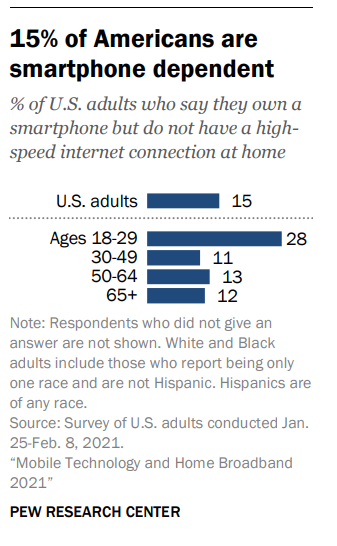

Secondly, I would suggest thinking more about what happens to websites after the marketing activity. One of the mistakes is not thinking about how to ‘convert’ visitors into customers. Here, it is worth asking yourself some questions: what keywords are visitors coming from? What will they do next on the page? In the case of an e-shop, the keyword is the sales pitch: will the visitor get something for free, or will they be greeted with a special greeting, such as a video?
Thirdly (though less so): the mobile user tends to be forgotten. The number of people using mobile devices to go online is constantly growing. It is worth considering colours, volumes, and the environment. So, in the context of a digital campaign, it is essential not to forget to increase the mobile advertising budget but to pay more and more attention to it consciously.
“So, within a digital campaign, you should certainly not forget to increase the mobile advertising budget; rather, it should be consciously given more and more attention.”
Helin: One observation, which is rather peculiar to Estonian marketers: often, there is a lack of courage to test new platforms.
There are a lot of networks and environments that are entirely undiscovered in the Estonian context. One of them is Reddit, which is used by young people in Estonia but is not yet thought about in the context of marketing and communication. However, new channels are particularly favourable for first-timers, especially in the start-up phase—no competitors and a higher chance to stand out.
Of course, one should not do something for the need of doing it, but if you notice that a friend or a mother, for example, is active in a new channel, it’s a sign that it’s the right channel to reach them. It’s worth a try. A user may already be drowning in ads on widely used channels such as Facebook!
“There is often a lack of courage in Estonia to test new platforms. There are a lot of networks and environments that are still completely unexplored in the Estonian context.”
3. Where will digital marketing be in five years?
Karin: Augmented reality combinations will probably be more available and used more avidly in marketing campaigns. This could mean more interactive advertising and new experiences for the customer—for example, the possibility of 3D viewing on the phone. Voice-activated driving is undoubtedly a keyword. Maybe even dare we say that 50% of the searches in the world will be voice-driven.
In addition, I believe that content will change significantly. People have less time to concentrate: we need to think about how to get the messages across concisely and what kind of content requires the least time and energy from people. I believe this principle will become even more rigid on a channel-by-channel basis, and the length limits for videos will also become shorter.
Helin: I agree that in digital and social media, we need to be even stronger in the future in the channels people use. The more convenient life is for the consumer, the better. Everything we don’t have online yet will move to the Metaverse.
Recommendations: where do you get inspiration and keep up to date with the constant changes?
Karin: What’s great about META is that we have experts in their field, the top of the marketing and communication world—working with them guarantees that you will learn every day. Secondly, we have industry-leading clients and client-facing managers, who need to keep up to date with the latest developments daily to provide excellent advice, but who also offer a diverse range of knowledge themselves. On digital marketing, I dare to recommend: HubSpot’s blog. For good visual reviews, check out Social Media Today.
Helin: I try to be open-eyed—to see new ideas and channels in everyday life. When I see a friend spending hour a day on Reddit, it’s clear that there are more like them.
For everyday social media use, I recommend LinkedIn: you can find a lot of useful material for professional use and exciting case studies and thoughts from experts there.
Meta team



Helin Naska Senior Consultant
META WAS AWARDED ‘PR AGENCY OF THE YEAR 2022’ TITLE
META Advisory was awarded the title of ‘PR Agency of the Year 2022’ at the oldest and most important marketing and advertising competition in Estonia, receiving two gold, two silver and two bronze awards for outstanding campaigns.
At the Kuldmuna 2022 creative competition party held at Põhjala factory on 13 May, awards were given to the most talented Estonian marketing, communication and advertising agencies and clients and their collaborative creative works. META, which won two gold, two silver and two bronze eggs, was awarded the title ‘PR Agency of the Year 2022’.
“While we strive to do gold standard work every day, there are some projects and campaigns that resonate more than others or have been particularly effective in helping clients achieve their strategic goals,” commented META partner Andreas Kaju. “This is the second time in the last four years that we have been titled ‘Agency of the Year’ and we can be sure that it will not be the last.”
META thanks its clients for the opportunity and trust to create new solutions where there is no previous case study. “We also send our congratulations and thanks to our good partners, because only with you it is possible to create campaigns that really work,” said Kaju.
“While we strive to do gold standard work every day, there are some projects and campaigns that resonate more than others or have been particularly effective in helping clients achieve their strategic goals.”
The jury selected the best entries in each category from a total of 822 entries. The PR jury included Ann Hiiemaa, META’s New Business Development Manager. In addition to her, there were six other members of the PR jury, including top people in their field from agencies, clients, both public and private sectors.
The organiser of the Golden Egg competition, The Association of Marketing Professionals (TULI), is an association of all marketing professionals whose mission is to raise awareness of the various aspects of marketing among local businesses and Estonian society as a whole. Kuldmuna, now in its 24th year, is therefore the oldest and most important advertising competition in Estonia.
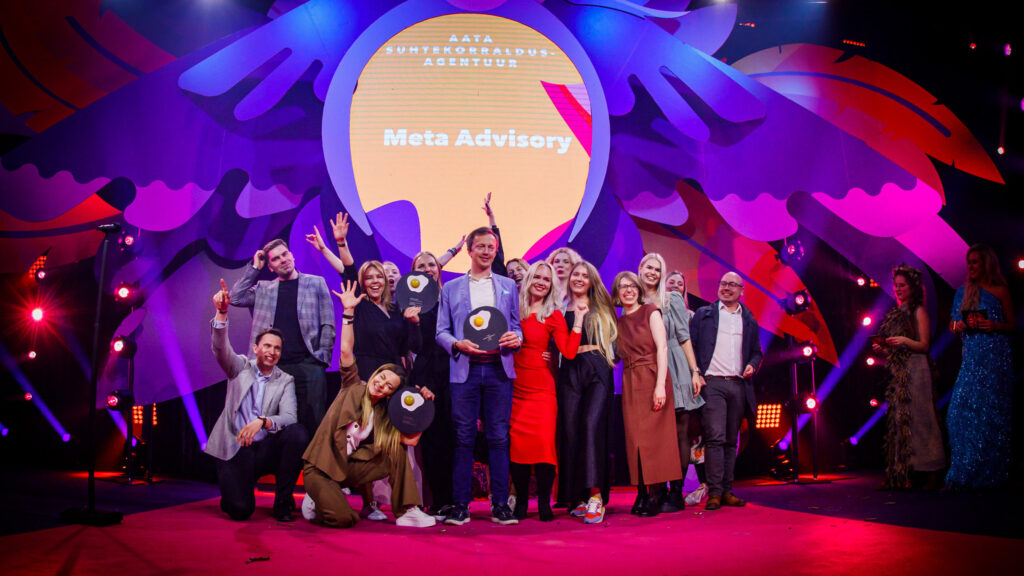

AWARDS
🥇 GOLDEN EGG
- Public Sector Communication
Digitally Wild press trip: how €45 000 brought €500 000 worth of media coverings
Client: Enterprise Estonia
Team: Mirjam Mäesalu, Maarja Karmin, Anni Türkson
. . . . . . . . .
- Influencer Marketing
Joel Ostrat’s Maestro burger in McDonald’s restaurants
Client: Premier Restaurants OÜ/McDonald’s Eesti
Team: Helin Naska
🥈 SILVER EGG
- Corporate Communication
How Tele2 cancelled its Christmas campaign
Team: Ann Hiiemaa, Lily Mägi, Laura Põldma
. . . . . . . . .
- Influencer Marketing
Dexcom Warriors
Client: Dexcom, Inc.
Team: Cairit Eit, Andreas Kaju, Rainer Laurits
🥉 BRONZE EGG
- Integrated Communication Campaign
Ivo Nikkolo rebranding communication
Client: Baltika AS
Team: Helin Naska
. . . . . . . . .
- Event Communication
Exhibition “Hirmus”
Client: Balti Jaama Turg/Astri Grupp
Team: Riin Härma, Kert Kask
Gallery
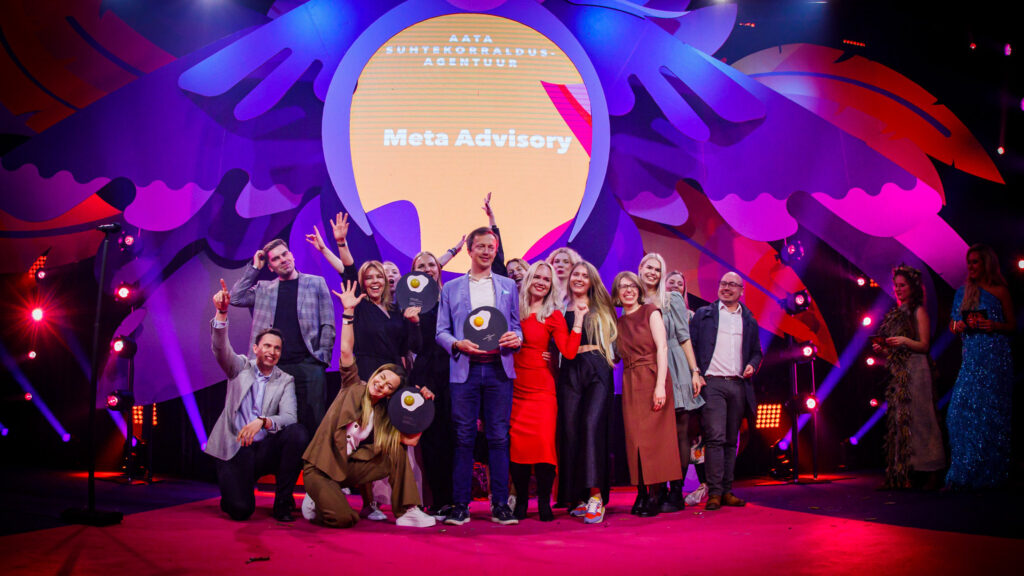

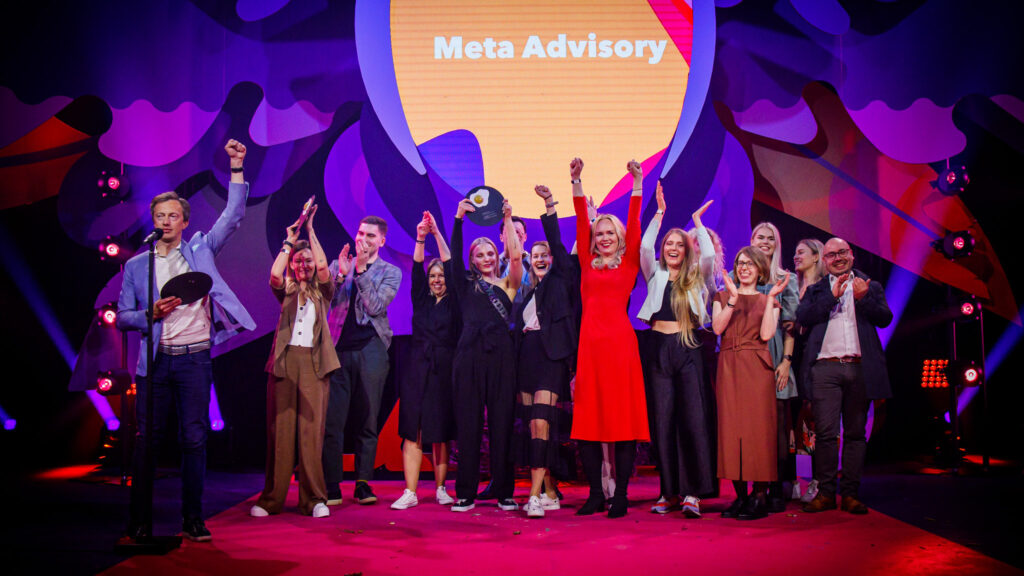

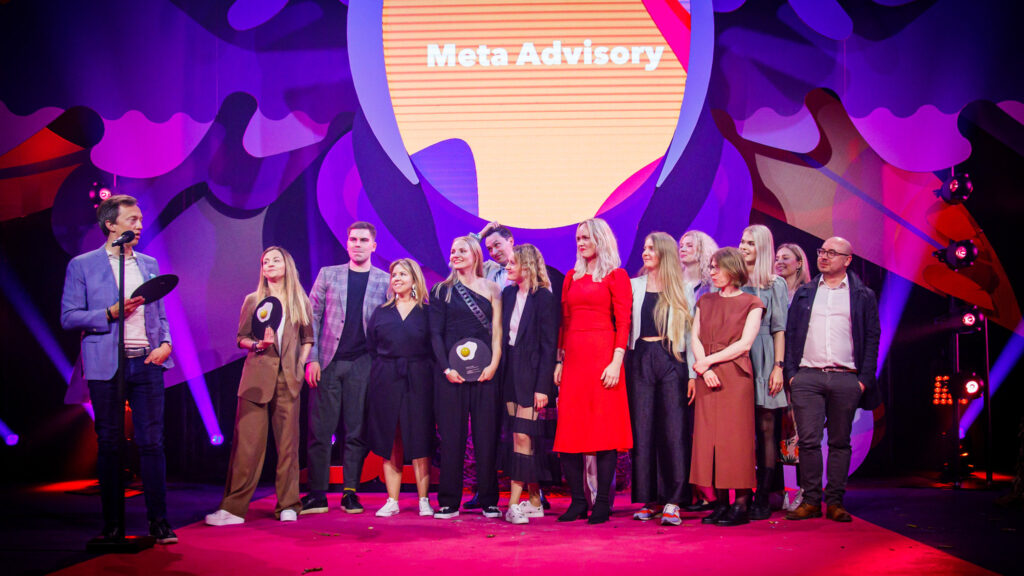

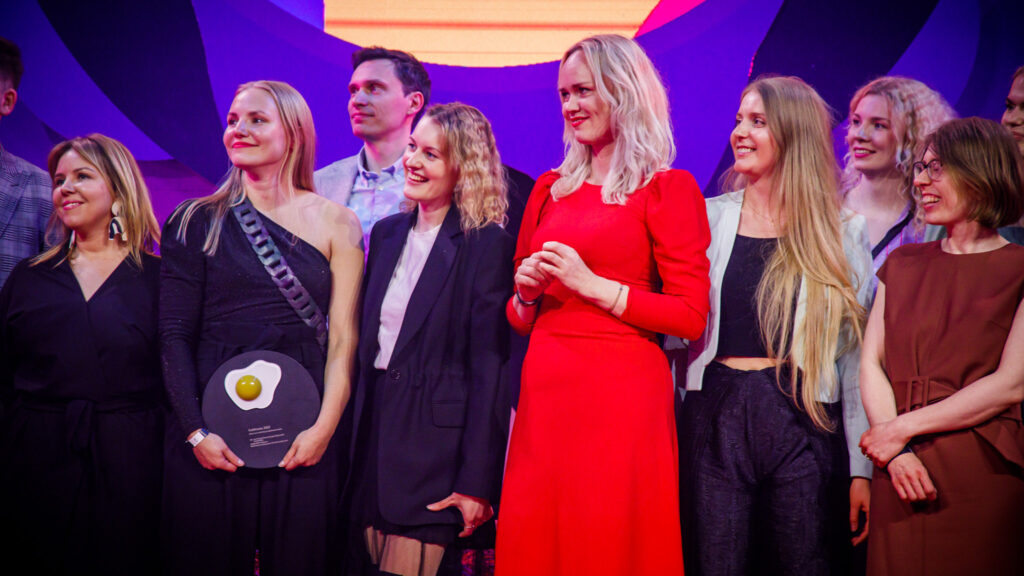





ANDREAS KAJU: HOW TO COMMUNICATE IN TIMES OF WAR?



Andreas Kaju, the founder of META Advisory, shares his recommendations on what to keep in mind when it comes to marketing communications in the context of the ongoing war in Ukraine.
1. In general, war references in brand communications should be avoided (an example: Shop X is sympathizing with the Ukrainian people; thus, it decides to change its social media profile picture). Or at least—if in doubt, don’t do it. Often such communication, regardless of the good intentions of the doer, is disrespectful of people’s real suffering, devaluing it. Clever copywriting won’t change that. This can sound harsh to the worried Estonian marketing experts, but your words are worth nothing in this situation. Instead, do something as we have real opportunities for that (introduced below).
2. Referring to war when used as an argument to sell products or services to people should be completely ruled out. If a company makes such claims in conjunction with a bargaining campaign, I would advise journalists to ensure if and where the company is donating. In any case, this should be ruled out. If you want to help, then help, but don’t tell the customer that I will help if you buy more of my products and services at such-and-such a price in the future.
Referring to war when used as an argument to sell products or services to people should be completely ruled out.
3. We will treat companies that publicly announce their donations to organizations and institutions approved by the Ukrainian state (or Estonia) with goodwill. Those who directly and authentically help the people in need deserve society’s appreciation. The actual cost and new risks will follow real aid in today’s world. In addition, courageous steps by companies help mobilize other supporters in society.
4. I would also recommend contributing to humanitarian aid. Organizations in Estonia have the experience and skills to use the money to ensure its impact. However, direct donations are currently the most effective (I believe that the Ministry of Finance will soon resolve the issues involved—so that donations can be made without paying income tax).
5. Many companies can also support by donating their products. This is entirely appropriate—before doing so, it is worth making sure which products meet the standards Ukraine needs and can use (these lists are available), and it is also worth consulting the Red Cross. In addition, the NGO Estonian Refugee Aid centralizes assistance to war refugees, and the Social Insurance Board should also be kept informed.
* Certainly, the preceding does not apply to the party at war. They are, of course, allowed to use the power of the word and the image to the maximum extent possible. In times of war, production is readjusted to what is needed at the time.
Internship at a government relations and PR agency through the eyes of #METAIQ interns
Thinking about doing a traineeship but not sure where, what and why? Would you like to know what an internship in government relations and PR agency is like? Let us help you clear your mind—previous participants of the METAIQ internship programme looked at their summer internship experience in the META team.
An internship is a unique opportunity to investigate a field of interest and put your theoretical knowledge to the test in practice. In 2022, for the third summer, META will organise the #METAIQ internship programme, where future PR talents, government relations experts, or digital and multimedia professionals will have the chance to roll up their sleeves and take a step towards their dreams.
Clearly, the journey from school to the first professional traineeship is not always easy. We know from our own experience that there are many questions that can arise when it comes to choosing a traineeship, such as: what to consider when choosing a traineeship? How to get the most out of the placement? Who would be suitable for an agency placement?
Our own #METAIQ trainees can provide the best answers and the most in-depth insight into these questions. We’ve met with many talented young people throughout the years, however, this time we spoke to four of them and asked them to look back on their experience.
Applications for the 2022 #METAIQ internship programme closed on 17 April!
Karolina Kadak | marketing communications intern 2020
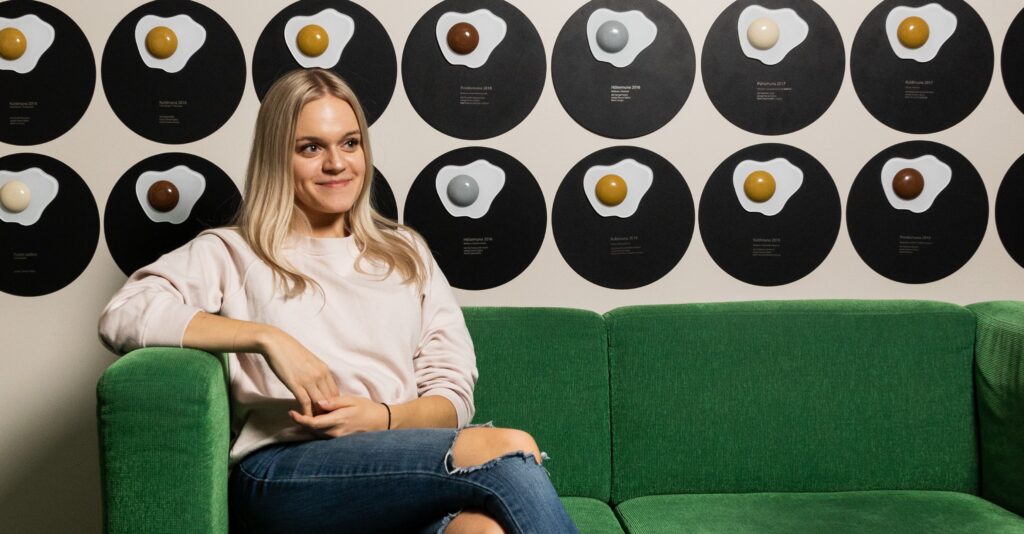

“An internship at an agency is a great foundation for an exciting career. It’s not easy to find such a variety of projects, opportunities to broaden your horizons, and a developing working pace.”
Read about Karolina’s internship experience
What is your professional background?
I am a student of Journalism and Communication at the University of Tartu. I have finished my Master’s degree by now, but I did my traineeship at META after my second year of undergraduate studies. Before that, my primary professional exposure to journalism was as a summer reporter position at Tartu Postimees a year earlier. I continued to write stories for them a co-author. Prior to the internship, I already had some association with communications as a Tartu Student Days’ media manager.
What makes the internship at the agency unique for you?
An internship at an agency is an excellent foundation for an exciting career. It’s not easy to find such a variety of projects, opportunities to broaden your horizons, and a developing working pace. What I liked most about the internship was the exposure to a diverse range of clients, projects, and tasks – the experience, knowledge, and courage I gained afterwards were much more remarkable. I felt as if I had gained the knowledge of several traineeships in a month.
What exactly did you do during your traineeship? Can you name a project or task that you were involved in at META that you enjoyed?
During my traineeship, I contributed to the development of communication plans, wrote press releases and other media texts, organized media lists, and monitored and summarised media coverage of clients. In addition, I was able to accompany my supervisor to client meetings, which gave me a fascinating insight into how agency-client cooperation works and how a project goes from brief to a fierce campaign. I can confidently say that I enjoyed all the tasks entrusted to me during my internship at META. The sparkle that came out of my training gave me the courage and the confidence to pursue my career in the communications field, working in an agency – today, I am a project manager in the PR team at creative agency Taevas Ogilvy.
What would you recommend to a student (in your field) who is still choosing a placement – what are the criteria for choosing a placement? What to consider when choosing a placement?
Try to get as broad a picture as possible of the opportunities in your field through internships. For example, if you are studying journalism and communication, I would recommend trying out both sides of the profession, regardless of where you initially see yourself in the future. The experience you gain in editorial work will definitely be helpful when you work in communication and vice versa.
I would recommend trying a traineeship in both the private and public sectors in communications. This way, you will increase your knowledge and experience and learn more about yourself through each placement. I can tell you from my own experience that, by adopting this strategy, even a newcomer to the profession will have a pretty good overview of their field by the time they start their first job, which will be hugely valuable in their future work.
Share three tips on how to get the most out of your traineeship?
1. Do a bit of preparatory work before starting your traineeship – find out more about the company/institution you’re going to. Find out what they’ve done that stood out and what their most exciting projects have been, and if possible, look at case studies and media coverage. Doing your homework beforehand will make it easier to settle in and undoubtedly help build mutual trust.
2. Think about your goals before the placement – in what areas and tasks do you want to be challenged? What contacts do you want to make? How could the placement develop your knowledge and skills? Setting goals helps you get the most out of your placement and helps you give your best, which is one of the biggest learning accelerators.
3. Appreciate your supervisor and the time they dedicate to you. Take the time to work through their guidance and feedback thoroughly – this will help you develop immensely and, in doing so, will build the confidence that will lead to exciting opportunities in the apprenticeship and help build a solid foundation for your career. Thank you, Riin!
Eero SIld |Government Relations intern 2021
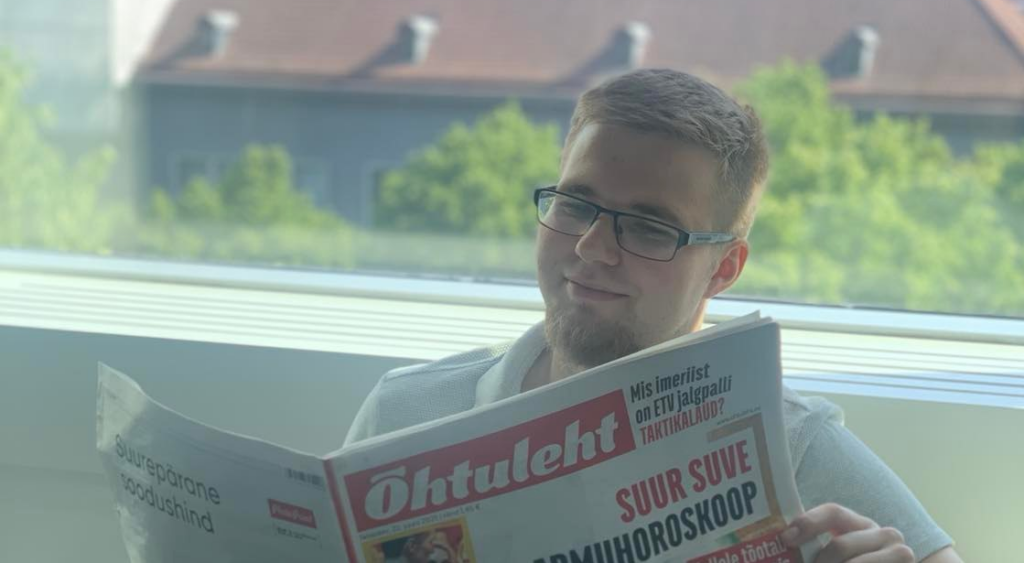

“Personally, I try to try something completely new every year – something related to my field of study, of course – so that I have a better understanding of what I want to do after my studies and what I’m really interested in.”
Read about Eero’s internship experience
What is your professional background?
Political Philosophy and International Relations, I have previously interned at the Ministry of Foreign Affairs.
Why did you choose META as your traineeship?
Purely out of personal interest: I had no idea what a PR agency did before working at META, and META was recommended to me by friends who had interned there before.
What makes an internship at an agency exciting or unique for you?
Being able to solve problems and perform tasks that are also done by paid staff – then a) I feel like a full member of the team and b) the internship also feels more rewarding because I get to see what the job is really like.
What exactly did you do during your traineeship? Name a project or assignment you worked on at META that you enjoyed?
I wrote reports and market research on new trends in the PR world, did translation work, and researched background information for a client. In addition, I produced monthly client reports. I enjoyed most gathering information and writing reports, as it was never routine. I felt that my work was valuable (bravo to META partner Andreas, who was very good at explaining the purpose and necessity of the tasks to the trainee).
What are the three biggest lessons you took away from your internship in government relations and PR?
The importance of the working environment – I felt valued by the employer at work, which also motivated me more. From the Coca-Cola in the fridge to the team events – it always felt like I was part of something bigger.
For PR work, it’s about character, not the professional background. I think that everyone can find a place in this field due to so many different types of clients and projects. But I suspect that psychologists and sociologists may have a particular advantage because I feel that PR is more about knowing people than products. Contacts are the most important thing when you’re doing relational work. It is probably impossible to set up a PR agency and find clients without a reputation and contacts.
What skills did the internship develop in you the most?
Prioritizing tasks and time planning. Also, the ability to say ‘no’.
What did your internship at META teach you about your own position?
It taught me that I don’t like routine work.
What would you recommend to a student (in your field of specialisation) who is still choosing an internship – what are the criteria for choosing an internship?
It’s worth thinking about what the placement will give you – whether and how much you will develop during the internship. For example, I try to do something completely different every year – something related to my field of study, of course – to have a better idea of what I want to do after my studies and what really interests me.
In three words, describe the atmosphere at META.
Positive, friendly, and mega-cool. I am grateful to the whole team for this experience.
Share three tips on how to get the most out of your internship?
Socialize as much as possible with colleagues (but not at the expense of work!).
When you run out of tasks – and this can happen – go and ask for more. At least in my experience at META, you don’t have to limit yourself to your supervisor – you can ask anyone. It was fascinating to see the PR side of things besides the government relations side. I think it fulfilled the whole internship experience.
And another important thing: if you don’t like something, say so. Really.
Keneli Pohlak | Marketing Communications intern 2021
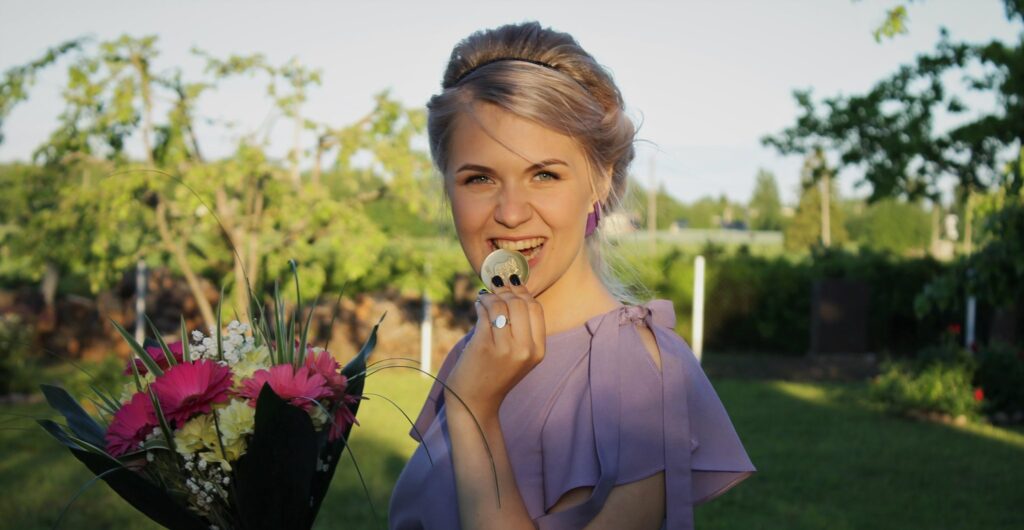

“All the more reason for me to be delighted to see the client’s final advertisements and visuals after the internship – both in urban spaces and in digital media. That’s exactly when I had the great feeling that the ideas that had been in my head and were being finalised together with my colleagues were being realised!”
Read about Keneli’s internship experience
What is your professional background?
When I started my internship at META, I was just finishing my first year at the Faculty of Economics at Tallinn University of Technology. I majored in Business Administration and, more recently, specialized in Marketing at the beginning of 2022. Therefore, from an academic point of view, I did not have much experience in marketing communication. However, just before my summer internship, I had applied for the marketing team of the solar car project Solaride (now the educational program Solaride Academy) in the spring. As a result, I was selected to the marketing team, where I made a giant leap in my professional background with the best mentors in my field.
However, I believe that having graduated from Väike-Maarja Gymnasium with a gold medal, while at the same time having been very active in student council activities as president and in several competitions and contests, I gained the experience to successfully take my first steps in the marketing world. Time planning, critical thinking, prioritizing activities, and finding solutions are essential keywords that will also come in handy when working in marketing.
After the internship, I was hired to work as a social media specialist to SPARK Studios. I’m sure that my internship was a great incentive to start working there because I fell in love with the thrill and pain of agency work!
Why did you choose META for your internship?
I didn’t have much of an agency background when I applied. I had heard about META’s work culture and projects from my cousin Kristi, who worked as a senior consultant about three years ago. I came across META’s internship opportunity advertisement on Facebook several times. I thought it was a sign to apply – so I checked the website and social media platforms for more information about the agency. I made a decision and finally used it. As a first-year student, I didn’t have high expectations, but the whole process went well!
Why did I choose an agency instead of a specific company’s marketing department? Definitely because of the broad focus. I wanted to get an overall experience, and that’s what the META internship provided. During the day, for example, I had to deal with a company in the logistics sector and the fashion sector, write an article in the food sector, and later work on a campaign for a group of shopping centres. Broadening my worldview and dealing with different companies was one of the best experiences during the traineeship.
What exactly did you do during the internship? Name some of the projects you worked on at META that you enjoyed.
During the internship, I was exposed to a wide variety of issues. For example, drafting media pitches for companies, coming up with campaign ideas, making presentations for clients, and writing content marketing articles and press releases. I hadn’t been exposed to many of these tasks, but the tutors were always beneficial and supportive. My two supervisors – Helin and Riin – were the ones who mainly gave me assignments, but when I felt I was getting more done, I would also ask other assistants for assignments.
The most exciting tasks were probably two large-scale campaigns. For both of them, I was more in the brainstorming phase at META, formulating the final ideas, so I didn’t get to realise them myself. This made me happier to see the final version of ads and visuals after the internship – both in outdoor advertising in digital media. That’s precisely when I had the pleasant feeling that the ideas that had been in my head and were being finalised with my colleagues were being realised!
Who would you recommend an internship at the agency to?
I would recommend a traineeship at an agency to young people eager to learn and ready to work in unexpected situations. To a young person who wants to gain different experiences by dealing with various clients and who wants to put what they have learned to work for them. For a young person who is not afraid to make mistakes but is willing to try. For the young person who wants to combine new creative solutions with solutions that have worked before.
It is certainly not worth being afraid of doing an internship. If you don’t try, you won’t know what works!
Share three tips on how to get the most out of your internship?
1. If you feel you could do more and want to try more during your traineeship, don’t be afraid to ask other colleagues for more. The great thing about META was that while on a day-to-day basis I was dealing with clients whose relationship was managed by my mentors, other colleagues had different clients and activities to try out whenever possible. So, once again, it broadened my horizons and allowed me to peek behind the scenes of other businesses in the sector!
2. Go to the office when possible and spend time with others during your lunch break. My internship experience wouldn’t have been like this if I’d spent all my time in my home office. You get to participate in so many eye-opening discussions and find fascinating information you might not have heard about before. But, of course, the main thing that is also constantly talked about at university – networking and contacts are essential! PS! Keep in touch with your fellow trainees – I never thought I’d find a good friend during my traineeship, and I’d still be exchanging ideas with her.
3. Offer your youthful ideas and share your own experiences. I had a fun situation. We were in the kitchen with a senior consultant, and we talked about posting on LinkedIn. One of META’s clients needed consultation on this very subject. I had recently spoken to a mentor from the Solaride student project before—about managing Solaride’s LinkedIn account—and the solutions that worked in this case. She also shared case studies and videos on how to work on the platform. When the topic came up in META’s office, I immediately shared my ideas and knowledge with the senior consultant – and even for her, a few ideas came as a surprise. So it was a real success! Plus, nothing is ever fixed in marketing—always offer all your ideas to find out the best ones.
Saskia Bergmann | Government Relations intern 2021


“One of the most surprising new insights was how positive government relations work could be. I had assumed—and sometimes experienced—that government relations were mostly about influencing policy through the private sector. Still, in many ways, government relations is also about helping firms adapt to new policies and be at the forefront of change.”
Read about Saskia’s internship experience
What is your professional background?
I am studying political science at the University of Amsterdam. Before META, I did an internship at the Ministry of Social Affairs. I am very interested in the view of political developments as a shaper of society; thus, how we achieve change through politics. The META internship was a great place to discover this.
What exactly did you do during your internship? Name a project or task you were involved in at META that you enjoyed?
At META, I produced a review of EU Green Deal policies and their impacts. At first, it seemed like a simple overview, but it turned out to be quite challenging and a lot of fun to process so much specific terminology and complex text!
I learned a lot about how the European Union works and got some excellent ideas about sectors to invest.
What are the three biggest lessons you took away from your internship in government relations and PR?
The biggest lesson was professionalism and regularity. Assignments had to be completed quickly but without sacrificing spelling, the visual aspect of the document, etc. One of the most surprising new insights was how positive government relations work could be. I assumed—and sometimes experienced—that government relations were mostly about influencing policy through the private sector. Still, in many ways, GR is also about helping firms adapt to new policies and be at the forefront of change.”
What skills did the internship develop in you the most?
In addition to the regularity mentioned above, I became much more familiar with the terminology used in government agencies, the documents, and the processes to follow. One of the most important skills was synthesizing complex texts into concise ones. The ability to be independent and entrepreneurial, think ahead about projects, and even have the courage to ask for new projects for myself was also important.
Who would you recommend an internship at an agency to?
I would recommend a traineeship at META to everyone! Even if it turns out that it’s not quite what you want to do, the experience itself is so valuable, educational, and fun that there is definitely no regret.
In three words, describe the working environment at META.
The META working environment is fun, open, and challenging.
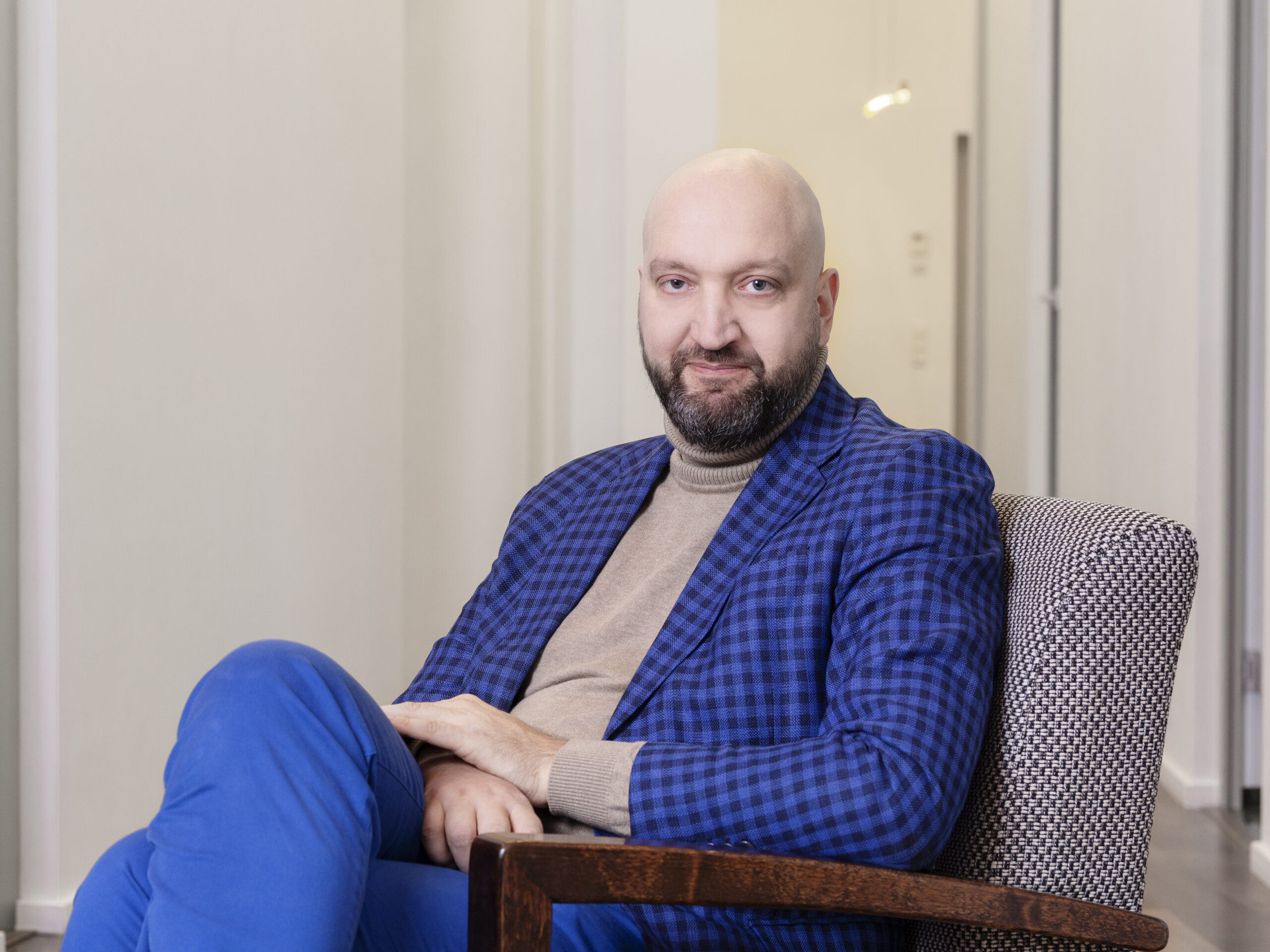

For the first time in Estonia, a party leader’s torch will be passed from father to son this weekend. There is nothing illegal about this, but it is an excellent opportunity to discuss political dynasties in a democracy.
More generally, the informality of the decision-making process is a crucial feature of political dynasties, and this brings with it a number of specific features. By the way, the informality of decision-making is not necessarily a family phenomenon. It can also be linked to a situation in which a person, who is not adequately placed in the decision-making hierarchy, can perform a certain level of functions. An interesting example in this respect is Margaret Thatcher’s press secretary, Bernard Ingham, who was the envy of members of Thatcher’s cabinet because it was by allegation he whom Thatcher listened to for advice on various sectoral policies (Ingham served Thatcher for 11 years and was knighted at the same time as Thatcher resigned).
There are political families in Estonia, but it is questionable whether we can speak of political dynasties in Estonia as in general, in democracy, a political dynasty would require a bloodline of at least three generations. So the Kallas, the Helmets, and the Savisards have another generation to work on. Of course, there are countries where the bar is much higher. For instance, in the United States, there are thought to be four political dynasties in all. These are the Adamses, the Harrisons, the Roosevelts, and the Bushes – all of whom have had at least two presidents in their own families. In American terms, the total number of political dynasties is thought to be around 40, the most famous of which are undoubtedly the Kennedys, the Clintons (Bill Clinton’s uncle was a member of the Arkansas State House of Representatives). Or, for example, the Cheneys, in whose family Dick Cheney is known to have been Bush Jr.’s vice-president and whose daughter is now a member of the US House of Representatives.
As expected, in European terms, political dynasties have a completely different meaning than the countries of South-East Asia, where combating them is, one might say, a discipline in itself. The most striking example is the Philippines. The political environment there is described as being controlled by totally different dynasties, controlled by seven families. This bizarre mix results from a corporatist political culture, widespread corruption, and a highly corporatist social model rooted in the colonial era. The political systems there have gone so far that, in the case of Indonesia (the world’s third-largest democracy), for example, a particular law has been passed banning close relatives of members of parliament from holding any public office for more than four years.
But in general, the emergence of political families is a socio-cultural phenomenon that is relatively fruitless to combat.
But in general, the emergence of political families is a socio-cultural phenomenon that is relatively fruitless to combat.
What causes this phenomenon? In environments where campaigning is extremely expensive, money certainly plays a significant role (USA). In Southeast Asian and Latin American societies, where we are talking about high levels of corruption and caste systems, the problem of hierarchical societies plays a role not only because of money but also because access to public decision-making is minimal. Even everywhere in the European Union, there is a principle that access to public decision-making is better for graduates of specific schools.
In the case of France, for example, it is the alumni of the École Nationale d’administration. A large number of French presidents, including Chirac, Hollande, Macron, and Giscard d’Estaing, not to mention prime ministers, a large number of whom are alumni of this school. Even though France has the most etatist tradition of national governance, educational background is always vital in political dynasties. And, of course, the individual’s brand always plays a major role in politics. In this sense, a person whose surname is, for example, Meri or Rüütel will always have an advantage over someone whose name is, for example, Kuusk or Kask. I know this first-hand, as I was involved in an experiment almost 20 years ago when I was asked to stand as a candidate for one of the first names of the President of the Republic of Estonia, who, without any campaigning, received around 400 votes in local elections.
By the way, there is also a considerable risk with political families – sons and daughters may not always be as successful as their parents.
Ann Hiiemaa: The Customer is the Hero of B2B marketing
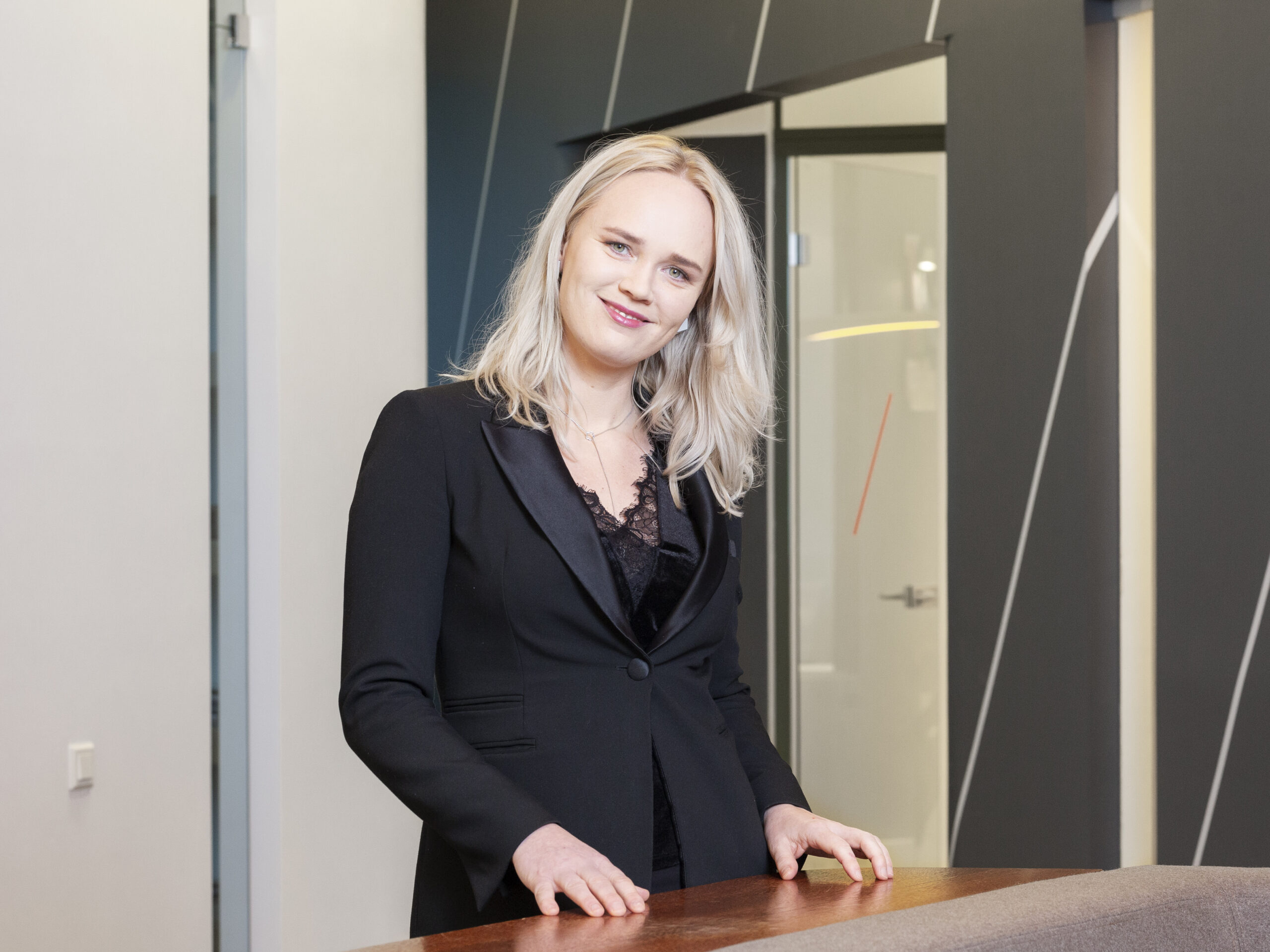

Who is the hero in the customer story? Who is the villain? And who are you?
I love people and their stories. One of my favorite movies is Moneyball, which is about baseball and how Oakland A’s coach Billy Beane found a competitive advantage in a non-existent budget by applying an in-depth statistical analysis for team building.
Based on Michael Lewis’ book Moneyball: The Art of Winning an Unfair Game, their film uses a classic model found in many other films as well. Such as in The Lord of the Rings, my other big favorite – Forrest Gump, and in films like The King’s Speech, Tenet, James Bond films, and in most fairy tales.
In short, the main character, our hero, wants to achieve something that is very difficult. The moment he almost gives up, the unexpected intervention of a helping hand appears (such as a guide, a music teacher, a muse, a business manager, a communication expert), offers a plan, and supports our hero in fulfilling their goal.
Of course, there is always a villain or an enemy in the story. And, of course, the hero ultimately achieves their goal. Why am I telling this story? Because in B2B communication the key is just the same story.
Key question for B2B communication – who is the Hero?
Donald Miller’s book, Building a StoryBrand: Clarify Your Message So Customers Will Listen, sets out a similar framework for selling your product: there is a hero, a villain, a guide, a plan, Calls To Action, failure, and success.
The story begins with a hero. Companies should always ask: who is the hero for them? And it can never be themselves, but rather it is their customer. The customer must always be at the heart of a B2B brand communication strategy. Focusing on a customer’s needs and desires is crucial.
And the hero can never be companies themselves, but rather it is their customer.
The basic questions to consider are: who is our customer, what are their main challenges and needs, how do they communicate with us, what channels do they use to find solutions to their problems, who is the person they listen to and respect? And, above all, how can our product or service help or support them? Your entire offer must be built on customer challenges and concerns.
What or who is the so-called “villain” for your customer? The problem that is frustrating them? It is not uncommon for a customer to be unable to phrase their problem – there is a pain, but where exactly?
The Guide – that is you
Now the guide comes into the picture, the one who helps the hero (the customer) win their challenge. The guide creates a plan to help the hero achieve their goals. At Meta Advisory, we always build our communication plans based on the customer’s business goals, as the role of the communication is to support business growth.
The guide offers valuable content and tips that help the hero reach a solution. Content creation is based on the journey the customer is facing – from looking for solutions to small victories. Therefore, the most important thing is to map the hero’s journey as accurately as possible.
For B2B companies, the minimum activities are a visually appealing website, strong copy, and a clear message built on the hero’s challenge. The next stage includes, customer stories(testimonials), exceptionally strong management analysis, webinars, field research, podcasting, and white papers – conceptual reports that reveal a specific problem area and the challenge as a whole: why it has been difficult to solve so far, what solutions have been attempted, summaries of specific literature, a new philosophical approach, etc. Once you have your message, you need to be where your customer is and speak to them in a way in which they get your message.
There is a tremendous amount of information available for B2B customers online. The competition for the attention of buyers is tough. Brent Adamson of research firm Gartner wrote, in the first issue of the 2022 Harvard Business Review, that B2B customers spend only 17% of their buying process talking to potential suppliers. All the preliminary work is done internally, by comparing and analyzing easily accessible information.
This 17% portion of time that salespeople have direct contact with the customer, should be used for getting a very simple message to the customer, so that the decision matrix they’ve already created, will generate the result that you are the solution for them.
Brent Adamson’s analysis coincides with what we, marketers, have learned about telling stories and being a guide to the customer. This 17% portion of time that salespeople have direct contact with the customer, should be used for getting a very simple message to the customer, so that the decision matrix they’ve already created, will generate the result that you are the solution for them.
It is important to make it crystal clear to the hero, what your company offers and how it will help them in solving their problems.
Personal branding
In order to be heard, a guide must first establish themselves as an authoritative source, gain an expert image and create common experiences of success, which are the basis for building further trust. People don’t always buy the products or services of the best company. They buy the products and services they understand. And today, they are more willing to buy these products and services from businesses that are well-known in their field and available at the critical moments the customer needs advice or help.
People want to work with otehr people, not companies.
Here, too, communication comes into play. There is a new era in B2B marketing – although most sales contacts are now remote and through electronic channels, paradoxically, so much more human touch is needed in communication. People want to work with other people, not companies. The challenge for the company is to find more people and characters from its teams, including sales teams, to introduce to their customer segments through the company’s own channels and earned media, and to build their marketing communication on real people. Of course, it also supports the pillars of the company’s reputation, and works together with employer branding, etc. Field experts and prominent people help build a strong brand, which in turn helps generate more sales.
Both general media and a company’s own channels must be used here. Today, there are quite a few of those who systematically and consciously build their personal brands on LinkedIn and general media. It also supports one of the most acute challenges for B2B companies today – recruitment.
Miller points out two aspects in his book – success and failure. In other words, what will the life of a hero be if they don’t buy from you, and what will their story be if they do. And we all know that their life would definitely be much more enjoyable if they bought from you.
Social media activism — a lazy or powerful tool?


Social media is a powerful channel that can be used for the benefit of a community. However, this requires a mastery of social media, says Laura Põldma, who studied the role of social media in community activism in her bachelor’s thesis.
- Creating a Facebook group for fighting against the closure of a hospital’s maternity ward and mobilizing a community with 3,000 members.
- Initiating an online petition to prevent the opening of a limestone quarry and the discussion of “a war strategy” in a closed social media group.
- Continuous content creation on the Facebook site of a small school to support the continuation of the school.
These are some examples of community activism in social media, which has been increasingly seen in Estonian public media in recent years. The internet is used not only by mass movements, but also by small community-based movements for whom social media offers the opportunity to express themselves both inside and outside of a local context[i]. The importance of social media as a networking tool is significant from the viewpoint of the internal dynamics of civic associations, as found by Tanel Vallimäe and Peeter Vihma, in an analysis of the results of a study conducted in 2019 by Tallinn University, the Institute of Baltic Studies, and Turu-uuringute AS, for evaluating the situation within Estonian civil society.[ii]
In the eyes of critics, on the other hand, online activism is simply slacktivism, an activity that can make people feel good, but has little effect on political decisions[iii]. So, how can social media activism be dealt with? Is it just an activity that distracts citizens from other, more efficient forms of participation? Or is social media a thermometer that enables the measurement of a community’s mood on a certain moment? And what about the opinion that being primarily active on social media and spreading one’s message there makes an initiative less serious?
In my bachelor’s thesis “The role of social media in community activism on the example of three conflict cases”, I studied the communicative aspects, specifically of the impact of social media on community activism from the point of view of mobilization and influencing activities in three cases: the Põlva Hospital Maternity Ward, the Lüganuse Limestone Quarry, and the Harmi Elementary School Discussions with initiative leaders as well as civil society experts – Hille Hinsberg and Martin Noorkõiv, highlighted several aspects that could help the 21st century activist to understand the role of social media from a mobilization and impact perspective.
Make the community’s opinion visible. Social media gives a community a voice and makes their outrage visible. The leader in one case study found that social media has made civil society more widely perceived, and there are many different opinions in Estonia about how to organize coexistence. The resulting pluralism is good, but there is also a downside in using social media to make resentment visible – the multiplicity of opinions. As one leader put it: when there are so many opinions, people in decisive positions may feel that it is never possible to consider everyone’s opinion. However, this hampers the activities of civil society. In such an increasingly “tight market” traditional methods – both demonstrations with slogans and protest events in Facebook – will eventually devalue.
Converting support to real actions. Social media can be useful for mapping support: one leader felt that Facebook was a kind of score-card or thermometer – as it was not known, at first, whether the community was happy with the respective closure. FB provided excellent input for leaders to understand the mood of the community. At the same time, is it worth paying attention to whether the extent of support and the thousands of members who joined the Facebook group add the actual value to the initiative? How many of those who are active on Facebook, are ready to do something in real life? This question arose for the activists themselves as well. Online activism has been seen as “lazy” activism, which speaks to persons who do not find time to participate actively.[iv]
At the same time, in the case of the Põlva Hospital’s Maternity Ward, it can be seen that activism, in the form of joining the Facebook group, was also expressed in real-life activities. A large number of signatures were collected – over 9,000 – and the collection of signatures on paper was not initiated by the leaders, but by other members of the community. In conclusion, it all depends on what other methods are used – combining different channels may help compensate the negative aspects of another. But you should compare comparable things. Many people, who are activists in social media, did absolutely nothing for the community in the past.[v] So, online activism is still better than no participation at all.
The digital gap in the digital country. Social networks include the risk of exacerbating inequalities if social media users tend to be more technologically skilled and have a higher level of human, social, and economic capital.[vi] It is worth noting that if an initiative is only active on social media, it may exclude part of a community from the debate. Be it older people or those who have consciously chosen to stay away from social media.
At the same time, one may ask whether Estonia, which is (according to the 2019 report of the European Center for Policy Studies) the highest-ranked country in the European Union in terms of digital learning and has a high level of computer literacy[vii], should worry about the digital gap at all? Although the problem may not be as great as in other countries, it is reasonable to consider that certain groups are more difficult to reach through online channels. Consequently, the combination of different channels and tools is also relevant in the context of the digital gap. In addition to creating a Facebook group, you should also bring your messages to the media, organize face-to-face events and, if necessary, establish direct contacts.
The issue of credibility. If an activity is only taking place in social media, its influence diminishes and decision-makers may think: “let them discuss it somewhere on their own and live out their resentment, life goes on”. Indeed: do decision-makers perceive a discussion in a Facebook group as equivalent to, for example, an editorial in an all-Estonian daily newspaper or a face-to-face meeting? There is no risk of social media not being taken seriously – the channel itself matters less than whether the message is “highlighted” in the channel, and whether the platform is right for spreading that particular message, i.e., the general ability to format and package the message. [viii] The impact of a media article can sometimes be much smaller than that of a social media posting, and a large number of voters in a group is much more influential for decision-makers.[ix]
Lack of social media competence and poor division of roles. As mentioned, social media gives communities a voice. However, not everyone’s opinion is always constructive. If the use of social media is unreasoned with several members of the community making random postings, it may not leave the best impression about the initiative. It is not necessary to censor, but a prerequisite for the successful operation of social media is a well-thought division of roles. It is certainly worthwhile to observe the experiences and journeys of other communities, as this can provide important knowledge.
Echo chamber effect. In conflicting cases of community activism, how the activists perceive the counterparts, their opinions, and arguments is important. Unfortunately, the features of social media (such as the ease of removing people from your friends list) encourage the emergence of echo chambers.[x] The “common reality” becomes socially validated in the echo chamber and can strengthen people’s world views. [xi] An explicit worldview and passion for a topic also tend to be expressed in more active, and often more emotional, speech. Although heated debates help to mobilize people, public debates are increasingly too emotional, leading to polarization and to not pursuing the long-term goals of defending the interests of communities.[xii]
In the context of influencing and the echo chamber effect, it is important to understand community awareness of how what decisions are made – and what is the vision of other stakeholders, including decision-makers – directly affects the success of protection of interests. A situation can easily arise, in an echo chamber, wherein excessive emotionality hinders the formation of constructive argumentation, and therefore directly prevents successful participation in the discussion. A situation should be avoided where officials make decisions based on economic considerations but are hit by activists with very different “sticks”. The degree of emotionality should depend on the goal of the community: for organising a great popular movement it can be efficient, but overly aggressive action can make politicians angry and work against the community.[xiii]
The spiral of silence. According to the spiral of silence theory, people censor opinions that they assume are unpopular.[xiv] It is clear that the wider the message of a community is, the more people fit under that wider message. By becoming too polarized and extreme (facilitated by the echo chamber effect) a community may lose members, as common ground becomes smaller and smaller. At the same time, it has been pointed out that due to the disappearance of walls around social environments, every narrator must consider whether they either insult someone or smooth their message to a degree that it is no longer attractive to anyone.[xv] Here, each community must find the right balance – to involve as many from the community as possible, but without losing its uniqueness.
Laura Põldma defended her bachelor’s thesis “The role of social media in community activism on the example of three conflict cases” this year at the University of Tartu. The full paper is available in the UT Digital Archive DSpace.
[i] Ruiu, M., Ragnedda, M. (2017). Empowering local communities through collective grassroots actions: The case of “No Al Progetto Eleonora” in the Arborea District (OR, Sardinia). The Communication Review, 20(1), pg. 51. https://doi.org/10.1080/10714421.2016.127227
[ii] Vallimäe, P., Vihma, T. (2019). Eesti mittetulundusühingud ja koostöö. Riigikogu toimetised, 40, pg. 185. https://rito.riigikogu.ee/nr-40/eesti-mittetulundusuhingud-ja-koostoo/
[iii] Christensen, H. S. (2011). Political activities on the Internet: Slacktivism or political participation by other means. First Monday, 16(2), pg. 9. https://doi.org/10.5210/fm.v16i2.3336
[iv] Cammaerts, B. (2015). Social media and activism. R. Mansell, P. Hwa (toim). The International Encyclopedia of Digital Communication and Society, pg. 7. Oxford: Wiley-Blackwell. https://eprints.lse.ac.uk/62090/1/Social_media_and.pdf
[v] Noorkõiv, M. (2021). Author’s interview in the framework of a bachelor’s thesis.
[vi] Valenzuela, S., Arriagada, A., Scherman, A. (2012). The Social Media Basis of Youth Protest Behavior: The Case of Chile. Journal of Communication, 62(2), pg. 13. https://doi.org/10.1111/j.1460-2466.2012.01635.x
[vii] Eesti on kõige digiõpihimulisem riik Euroopas. (2019). HITSA, 11. December. Kasutatud 02.02.2020, https://www.hitsa.ee/uudised-1/eesti-on-koige-digiopihimulisem-riik-euroopas
[viii] Hinsberg, H. (2020). Author’s interview in the framework of a bachelor’s thesis.
[ix] Noorkõiv, M. (2021). Author’s interview in the framework of a bachelor’s thesis.
[x] Greijdanus, H., Fernandes, C. A., Turner-Zwinkels, F., Honari, A., Roos, C.A., Rosenbusch, H., Postmes, T. (2020). The psychology of online activism and social movements: relations between online and offline collective action. Current Opinion in Psychology, 35, pg. 50. https://doi.org/10.1016/j.copsyc.2020.03.003
[xi] Greijdanus, H., Fernandes, C. A., Turner-Zwinkels, F., Honari, A., Roos, C.A., Rosenbusch, H., Postmes, T. (2020). The psychology of online activism and social movements: relations between online and offline collective action. Current Opinion in Psychology, 35, pg. 50. https://doi.org/10.1016/j.copsyc.2020.03.003
[xii][xii] Vallimäe, P., Vihma, T. (2019). Eesti mittetulundusühingud ja koostöö. Riigikogu toimetised, 40, pg. 182. https://rito.riigikogu.ee/nr-40/eesti-mittetulundusuhingud-ja-koostoo/
[xiii] Hinsberg, H., Noorkõiv, M. (2021). Author’s interviews in the framework of a bachelor’s thesis.
[xiv] Greijdanus, H., Fernandes, C. A., Turner-Zwinkels, F., Honari, A., Roos, C.A., Rosenbusch, H., Postmes, T. (2020). The psychology of online activism and social movements: relations between online and offline collective action. Current Opinion in Psychology, 35, pg. 50. https://doi.org/10.1016/j.copsyc.2020.03.003
[xv] Viik, K. (2019). Konteksti häving sotsiaalmeedias. Postimees, 17. October. Used 11.01.2020, https://kultuur.err.ee/992749/kadi-viik-konteksti-having-sotsiaalmeedias
META insights on Estonian local elections 2021


It is clear that the power dynamics in Estonian politics are changing, with the Centre Party’s strategy needing revision.
Estonia held its local elections with the final day of voting taking place on October 17th and with more than 1000 councillors elected in 79 municipalities. These were one of the most significant local elections in recent history as the ruling party in Tallinn, the Centre Party (ALDE), lost its hold on the city council for the first time in more than a decade, having been kept short of the absolute majority of 40 seats in the 79-seat chamber. How will this exactly affect national politics – and especially the current coalition government between the centre-right Reform Party (ALDE) and the centre-left Centre Party – is to be seen in the coming weeks.
These were one of the most significant local elections in recent history as the ruling party (ALDE) lost its hold on the city council for the first time in more than a decade.
However, coupled with the Centre Party’s clear loss in their second key constituency of Narva, with also disappointing results in the cities of Tartu and Pärnu, the future of the Centre Party’s leadership might be contested, with ramifications in national politics. The former prime minister Jüri Ratas, also the chairman of the party, will have to provide for changes in strategy and team, to hold off contenders, as the general elections of 2023 are looming on the horizon and projecting the local election results onto the national level, the picture is not satisfactory.
Nationwide results
If arbitrarily summarized, the elections were won by the Centre Party with a small lead ahead of the various local electoral alliances. The latter are popular in local elections, especially in smaller municipalities, where national party affiliations matter less and often people of different party leanings coalesce into one candidate list, based on local political sympathies.
| Party | 2021 elections | 2017 elections | Change, %-points |
| Centre Party (ALDE) | 24.4% | 27.3% | -2.9% |
| Electoral alliances | 24.3% | 27.2% | -2.9% |
| Reform Party (ALDE) | 17.3% | 19.5% | -2.2% |
| EKRE (ECR) | 13.2% | 6.7% | 6.5% |
| Pro Patria (EPP) | 8.4% | 8% | 0.4% |
| Eesti 200 (n/a) | 6% | n/a | n/a |
| Social Democrats (PS) | 5% | 10.4% | -5.4% |
The Capital City of Tallinn
Although the Centre Party increased its voter share in comparison to last local elections in 2017, they have to forfeit their one-party rule. This is due to the higher number of parties who made it above the 5% threshold. The modified d’Hondt system of electoral mechanics means that the votes that are casted for parties which wind up receiving less than the 5% threshold are divided among the successful parties with most of the votes tending to go to the election winner.
| Party | 2021 elections | 2017 elections | Change, %-points |
| Centre Party (ALDE) | 45.4% | 44.4% | 1% |
| Reform Party (ALDE) | 17.8% | 20.5% | -2.7% |
| EKRE (ECR) | 9.5% | 7% | 2.5% |
| Eesti 200 (n/a) | 9.5% | n/a | n/a |
| Social Democrats (PS) | 7.5% | 11% | -3.5% |
| Pro Patria (EPP) | 7.1% | 6.6% | 0.5% |
As can be seen from the vote share and the council seats (Table 2 and Table 3), the key component in current elections was the success of newcomer Eesti 200. The party was founded ahead of the last general elections in 2019 where they were unsuccessful in gaining seats in the parliament. However, the party continued its work and has now officially cemented themselves in Estonian politics with strong representations in the key cities of Tallinn and Tartu.
| Party | 2021 elections | 2017 elections | Change |
| Centre Party (ALDE) | 38, out of 79 seats | 40, out of 79 seats | -2 |
| Reform Party (ALDE) | 15 | 18 | -2 |
| EKRE (ECR) | 8 | 6 | 2 |
| Eesti 200 (n/a) | 7 | n/a | n/a |
| Social Democrats (PS) | 6 | 9 | -3 |
| Pro Patria (EPP) | 5 | 5 | 0 |
| Other | 0 | 1 | -1 |
In the coming days, the parties will launch coalition talks. The Centre Party will be most likely to try to secure a coalition with the Social Democrats, as this would be both ideologically the soundest and easiest to manage also from the point of view political chemistry. Another option would be to tie the knot with political newcomer Eesti200. However as a new, sort of a centrist, high-brow technocratic party, its demands on how the city should be run are from one perspective very sharp and from another, its real political philosophy is still so vague that it is hard for a partner to gauge long-term viability of co-operation.
Further takeaways
The second largest city of Tartu remains in the control of the prime minister’s Reform Party. This has been the stronghold of the party since the end of 1990s. However, as usual in Tartu, they must find a coalition partner, with the Social Democrats and Pro Patria looking like the most promising partners. The newcomer Eesti 200 is an unlikely candidate as they had made a lot of fuss about replacing the Reform Party altogether in the electoral campaign and the personal chemistry might not be there between the two parties.
The troubling situation might provoke [Jüri Ratas] into rash moves, destabilising the already embattled government.
Perhaps another one of the most notable outcomes of the local elections was the clear loss of the Centre Party in its second key constituency, the predominantly Russian-speaking city of Narva. This has been under the sole governance of the Centre Party for more than two decades. The weakened position of the Centre Party in Narva, as well as their clear losses in the other key cities of Pärnu and Tartu further mixes up the power dynamics in the national government, with the party leader Jüri Ratas on the defensive. The troubling situation might provoke him into rash moves, destabilising the already embattled government that has been struggling with the lagging vaccination drive.
The right-populist EKRE also consolidated some of its promising growth into results. The party which gained access into the parliament only in 2015 on the back of the EU immigration crisis as well as protest against national civil union legislation, has been growing its national party apparatus.
While the gains in many places were remarkable, then the party’s summarized results fell short of their own expectations. In the national polls that simulate general election support, they have been neck and neck with the leader, the Reform Party. However, EKRE’s local election results came in with just half of what the national polls had been promising, meaning that the party’s messaging – while appealing to many that are generally concerned about their lives and future – do not impact practical electoral behaviour to the same extent. Furthermore, the party, due to its extremist image, has still a hard time appealing to brand name candidates. Outside of the party leaders, very few names carry similar weight.
Summary
The next general elections take place in early 2023. While the Prime Minister’s Reform Party, despite of the difficulties of running a coherent COVID19 national strategy, seems to have gone through this test intact, it will be facing Eesti 200 as a serious challenge to some of its more liberal voters, especially in the bigger cities. Their concerns might be relieved only by the Centre Party’s relative weakness outside the capital city of Tallinn – taking into account also that many of the Centre Party’s non-citizen voters cannot vote in parliamentary elections. The rise of the right-populist EKRE, also seems to have made it through their first test, with the results indicating, that further normalization of the party’s core needs to take place to broaden support (i.e., mainstream messaging and stronger candidates).
Almost missing from the political map are the Social Democrats. Although in many places, their local party organizations were part of politically non-affiliated candidate lists, then their results in the bigger cities were still really disappointing for the party. Their search for new leadership and positioning, between the centre-right Reform Party, the centre-left Centre Party and yet non-ideological technocratic Eesti 200, continues without a solution in sight.
5 tips for influencers for an effective cooperation: PR agency’s view


The title influencer can be attributed to virtually anyone active on social media. Social media gives a voice to everyone – anyone can create content.
Having worked as a PR consultant with world-renowned brands and many content creators, I have made a number of observations over the years that could be useful both for a content creator and their client. What are the best practices for influencers, and how can routines be put in place to help ensure that a client returns?
1. Stay loyal
One of the biggest mistakes an influencer can make is to rush into a new collaboration with their client’s competitor immediately after the end of the cooperation with a client. This does not leave a good impression on cooperation partners or agencies. As an influencer you should maintain your authenticity and stay loyal to those brands with whom you have had a good cooperation, and whose products you use outside of a work relationship.
This way, you secure your professional image and show authenticity to your followers. This will increase the chances that a client will want to work with you again – you never know, maybe they will offer you a proposal for a long-term cooperation or an opportunity to develop a completely new product together.
2. Don’t become a Top Shop ad
This and the first point complement each other. Brands like faces who talk about products with their own character and humour, and are not already “overused”; meaning those influencers who are selective, and don’t take each and every offer.
Usually the influencers who are truest to their personality and interests, tend to receive the most offers to cooperate. Thus, it is up to the influencer to decide whether they will become just another advertisement somewhere on the main street or retain the specific content of their channel and match the brands with it, not vice versa.
3. Deadlines, deadlines, deadlines – it’s crucial
Yes, it is really important to meet deadlines. Campaigns are planned for specific periods, and in most cases, working with an influencer is only one part of an entire larger campaign. This means an attitude of “it doesn’t matter when I post the content” is definitely not the way an ideal partner would think.
It is worth noting that the need to ask and prompt about deadlines becomes incredibly inconvenient for project managers pretty quickly. It is unlikely that a person who disrespect agreements will be involved in a campaign next time.
4. Don’t black out any potential customer
So many influencers have publicly stated that people should take their work more seriously – content creation takes a lot of time and preparation. This is 100% true.
However, it is also important that an influencer maintains a serious image. Hence one of the most basic tenets is: public defamation of clients, both potential and existing, does not create any credibility and is uninviting. It is worth considering that Estonia’s small size means that stories about experiences, both good and bad, move quickly and such experiences do not stay unnoticed by others.
Of course, this does not mean that feedback about a cooperation should not be given. On the contrary: if you do not like something or have ideas about how to make something better in the future, you should tell your client. This is exactly how agencies work with their clients.
5. Share statistics and feedback
The brands themselves also want feedback. If something is wrong with their product or needs further development, such direct feedback from the consumer is extremely valuable.
Seeing an influencer’s statistics is also very useful and informative for a brand. Although most companies ask for that themselves at the end of a cooperation – or sometimes before beginning – a cooperative and proactive approach by an influencer is especially pleasing. Sharing important information and data on your own initiative is a sign of professionalism and openness to a client.
Andreas Kaju: Open Tap Policies Have Rarely Brought Long-Term Success



This article first appeared in Äripäev on 15 May 2021.
I am concerned about the sloganeering of the debate on the state budget and the national debt. It can give the impression to a citizen who is informed only through the press that on one side of the debate there are fiscal conservatives defending the principle of a balance between expenditure and revenue, and on the other side there are ideologues with good ideas and a desire to find the money to bring them to life.
The real starting point is this. Estonia’s debt level has already risen threefold in the last two years, from 8.4% of GDP to 23.6% of GDP, and the structural fiscal position of the general government has increased by the same magnitude, from 2.7% to -6.6%. Every second, Estonia borrows to finance its existing legal obligations, without a blink. And the artificial recession caused by pandemic restrictions (which are holding back supply; there is plenty of demand) is not yet over. Maybe we will live like this for years to come, where we will have to subsidise the recovery of whole sectors of the economy with wage subsidies and so on. All of this is obviously necessary, because society will bear the excess costs in solidarity to protect the most vulnerable.
In other words: In Estonia, the budget deficit is growing even before any debate, and it has been so for several years before the crisis, when, despite economic growth, it managed to spend more than it raised.
Concrete-constrained fantasy
The ‘open taps policy’ of which Finance Minister and Prime Minister Otto Strandman accused Konstantin Päts, and which led to his dismissal as head of state back in 1924, has very rarely been a long-term success. In the short term, of course, it is inevitable in pandemic circumstances – the euro area’s public debt has also crossed the 100% of GDP threshold and avoiding social collapse is the government’s first task. The problem is, above all, that Estonia has not yet had a government that has been able to open the taps and make long-term investments, in addition to covering current expenditure, without visible results before the next elections.
The ‘open taps policy’ of which Finance Minister and Prime Minister Otto Strandman accused Konstantin Päts, and which led to his dismissal as head of state back in 1924, has very rarely been a long-term success.
This is why the so-called investment money is always poured into concrete and asphalt. For example, in the health sector in Estonia, almost the entire period of EU membership, structural funds and co-financing for investments have been used for concrete investments.
Even today, fantasy is limited to concrete. A major project for the new Tallinn hospital may be justified to consolidate the existing city hospitals operating in old buildings, but in the circumstances where we have regional hospitals PERH and TÜK and already today one does not have enough residents and the other does not have enough patients, our real estate-oriented investment philosophy is simply strange.
In education, too, investment has always been only in building houses. In a country of faith in education, the popularity of the teaching profession is still among the lowest in the OECD countries, because children leaving school see how difficult it is for a teacher to be alone in the classroom and how little real support he or she has.
The reason for investing in building is that the process is simple, the result tangible. We order the houses, the bank knows how to price, the builder builds, the owner depreciates, and for a while everyone is happy, the economy grows.
The state is a poor investor not only because these investments are not managed as they should be, but also because it does not know how to invest. With a low appetite for risk (historically, KredEx’s business support measures have been so conservative that demand for them has sometimes been poor, although the situation has improved in recent months) and a time horizon that is always close at hand, the state does not invest in companies at the crossroads of science and modern manufacturing in Estonia, or in education and science, but primarily in construction.
Take a look at Finland or Germany – what is the level of investment there by the public sector, central government or counties and cities? There is competition for production and technology transfer opportunities for companies, and centres of excellence are set up with innovative R&D-intensive companies. In the health sector, interesting new interventions and prevention policies are being funded to help extend healthy life years.
I am not going to talk about 6G, artificial intelligence, the energy revolution or the impossibility of developing any industry at all outside Ida-Virumaa region in Estonia.
Our great development obstacle
If the government wants to invest, it should do so where private sector investment and the expected impact would otherwise not reach. In today’s macro-environment, any marketable business idea can get money, it doesn’t necessarily need the state. Yes, Estonia’s capital market is still fragile, but the rapid development of recent years has included the growth of local investment firms and hedge funds. In Estonia, it is easy to start a new business, raise money, develop it, sell it and start again.
In today’s macro-environment, any marketable business idea can get money, it doesn’t necessarily need the state.
Where there is not enough private capital in Estonia: fundamental and applied science, universal education, giving all children a level playing field, but also political competition to attract or retain large investments.
The Estonian economy is actually doing well at the moment, even if it is hard to believe in the middle of a pandemic. It does not need concrete money. Estonia, like many other countries, has one major brake on development – a chronic shortage of people with different skills. This is true in the fastest growing and highest value-added technology industries but also in agriculture and food production, health care and the service sector. Everywhere. No people, no skills. If we can create a greater concentration of people and skills, there will be growth, innovation (which unambiguously depends on the concentration of talent and interactions between them) and culture.
Finally, a reminder for our fellow entrepreneurs. As soon as the new government’s tax peace is over, the debate will begin on how to plug the annual deficit with rising budget revenues in addition to borrowing. Money can be taken from where it is earned. In Estonia, the Reform Party has always loved to tax consumption, while the other major parties have never had any serious ideas to put on the table (to Jüri Ratas’ credit: he did try to start a tax debate, but the pandemic and real life ruined it). Unless people’s grocery list or homes are not to be taxed further, the money will have to come from where it is. You know.


NB! Microsoft on loobunud Internet Exploreri arendamisest ning sellele uuenduste tegemisest ja ei soovita antud internetibrauserit turvanõrkuste tõttu kasutada. Internet Explorer ei toeta enam uusi võrgustandardeid ning antud veebilahendus ei tööta siinses brauseris korrektselt.
Palun lae alla mõni moodne veebilehitseja:
The website uses cookies. Cookies are required for your convenience and web statistics. By continuing to use the website, you agree to the terms of the privacy of cookies! You can see the terms of the privacy policy in here.
